An unusual way to gain additional speed quickly during takeoff?
Disclaimer: Prepare yourself, these are some of the messier photos I’ve posted to my blog. The hawk almost gets lost in the incredibly busy setting and except for the first photo I didn’t get catch lights in his eye. But this post is about behavior rather than aesthetics.
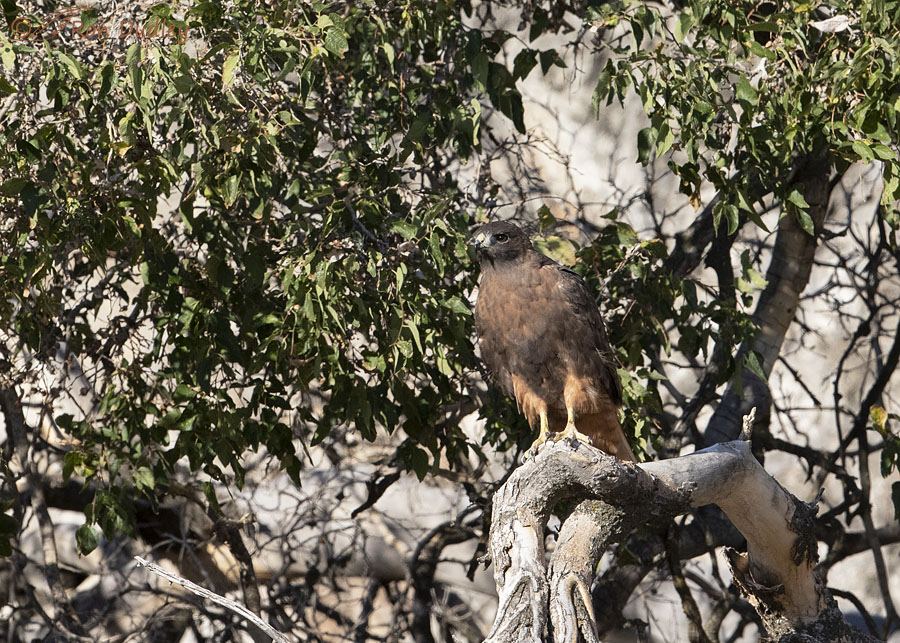
1/2500, f/6.3, ISO 800, Canon 7D Mark II, Canon EF 500mm f/4L IS II USM + EF 1.4 III Extender, not baited, set up or called in
This is our old friend the rufous male Red-tailed Hawk I photographed four days ago. I watched as he carried a vole in his talons and landed with it on this perch. The large, twig-free branch made an ideal dining table that I suspect he may use often while tearing apart and eating prey. I took many photos of him as he was eating the vole but with the background so close they didn’t turn out very well.
In this shot he had finished his meal, cleaned his beak and turned around to face the direction he flew in from. As usual I was after takeoff and flight shots so I composed him in the frame in a manner I thought appropriate for takeoff and tried to anticipate his direction and angle of launch.
Immediately after takeoff he pulled a maneuver that made me say, out loud, something like “Wow, what just happened there?”. I didn’t know for sure what I’d seen until I looked at my photos at home.
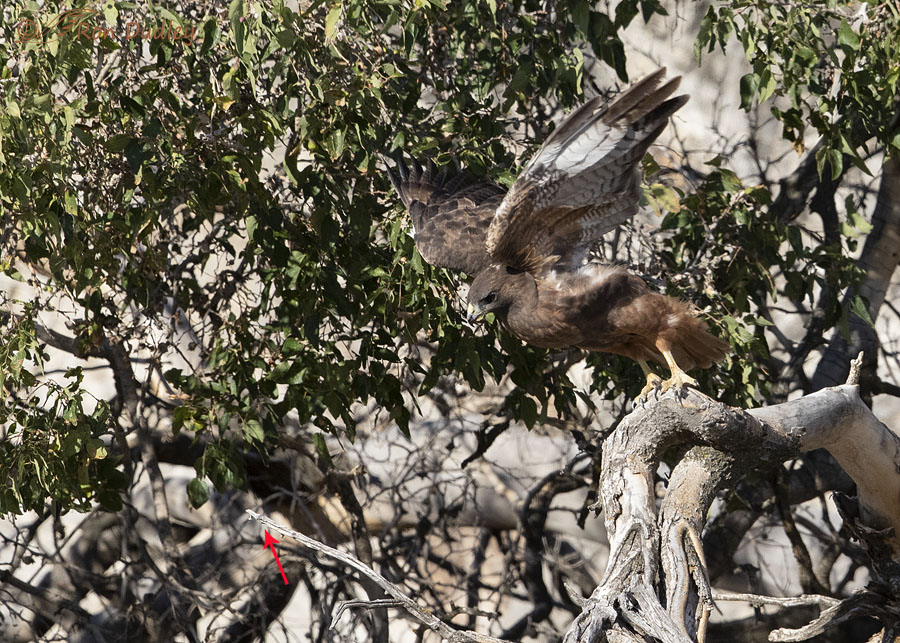
1/2500, f/6.3, ISO 800, Canon 7D Mark II, Canon EF 500mm f/4L IS II USM + EF 1.4 III Extender, not baited, set up or called in
The moment of takeoff. This photo allows me to see something I didn’t have time to notice when it was happening – he’s looking down rather than forward as I would expect him to in this situation. He has plans for the smaller branch I’ve marked with a red arrow so keep your eye on it.
These photos are sequential shots in a burst. It’s important that you keep in mind that there’s only 1/10th of a second between each photo – the entire maneuver occurred very, very quickly.
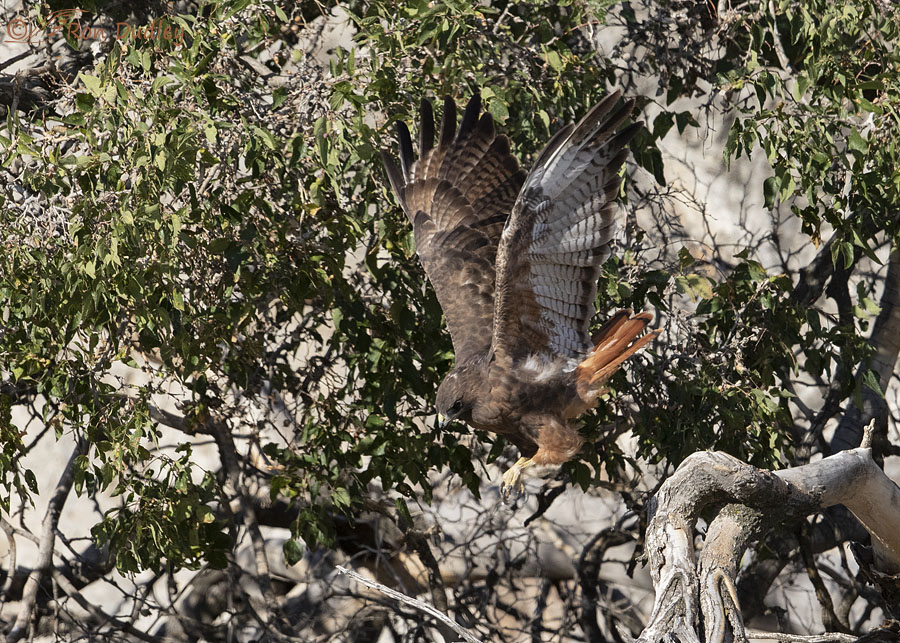
1/2500, f/6.3, ISO 800, Canon 7D Mark II, Canon EF 500mm f/4L IS II USM + EF 1.4 III Extender, not baited, set up or called in
He’s left the perch and now he’s looking down at an even steeper angle directly at the smaller branch, even though he doesn’t intend to land there..
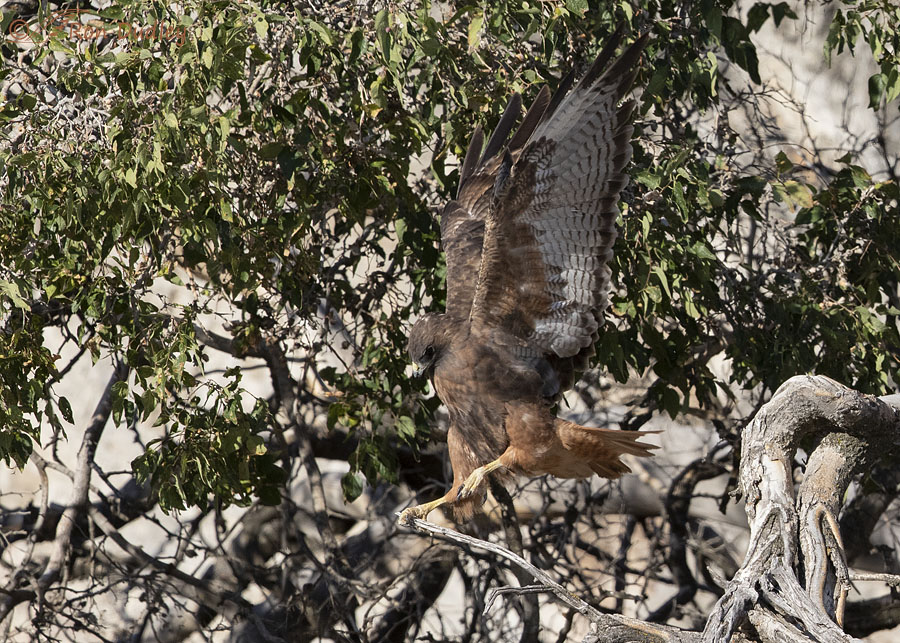
1/2500, f/6.3, ISO 800, Canon 7D Mark II, Canon EF 500mm f/4L IS II USM + EF 1.4 III Extender, not baited, set up or called in
As he passed over that branch he grasped it with his right foot.
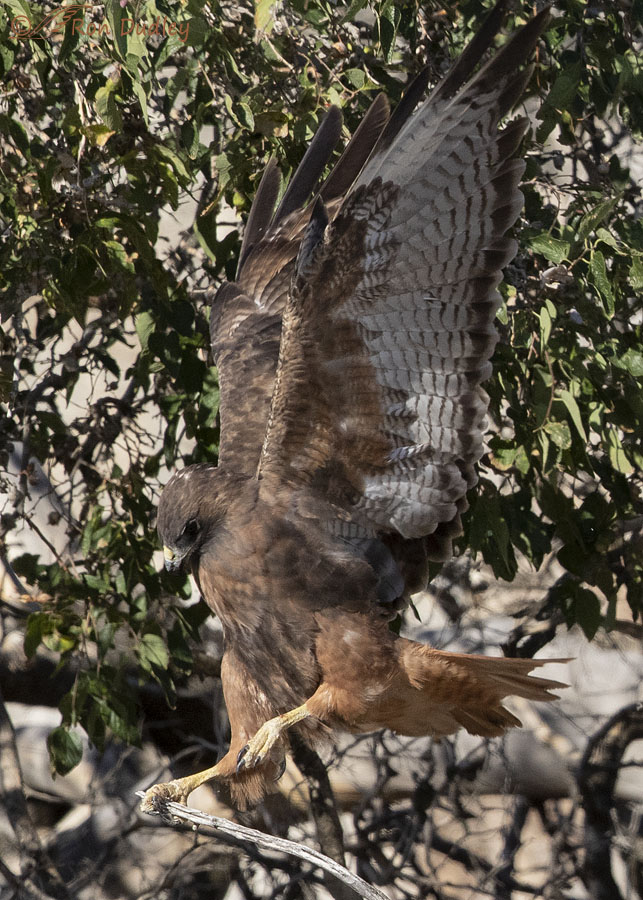
1/2500, f/6.3, ISO 800, Canon 7D Mark II, Canon EF 500mm f/4L IS II USM + EF 1.4 III Extender, not baited, set up or called in
A tight crop of the previous photo gives us a better look at what he was doing with his right foot. It almost looks like his intention was to land on that branch.
.
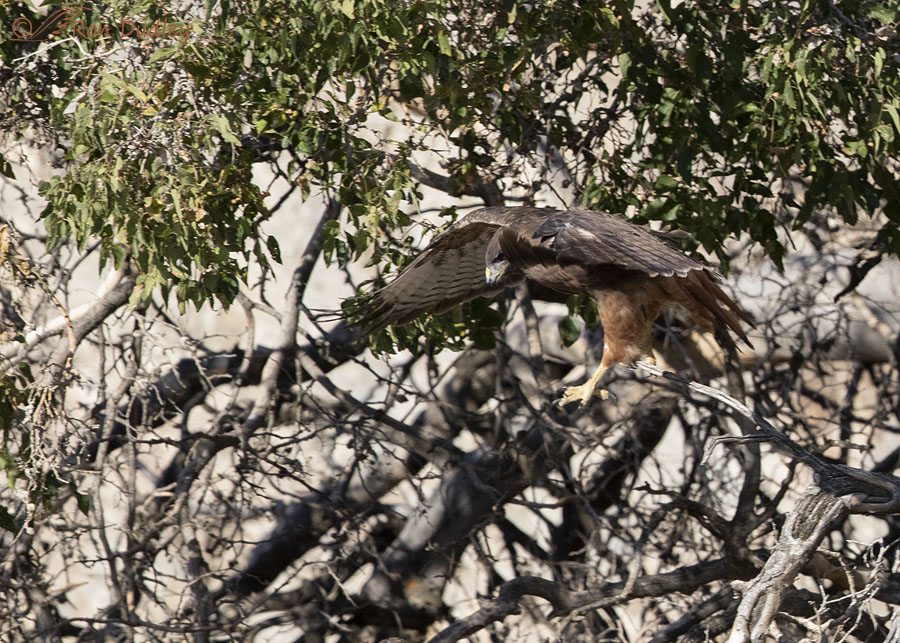
1/2500, f/6.3, ISO 800, Canon 7D Mark II, Canon EF 500mm f/4L IS II USM + EF 1.4 III Extender, not baited, set up or called in
But he didn’t. He didn’t touch it with his left foot and he didn’t even slow down as he passed over the branch..
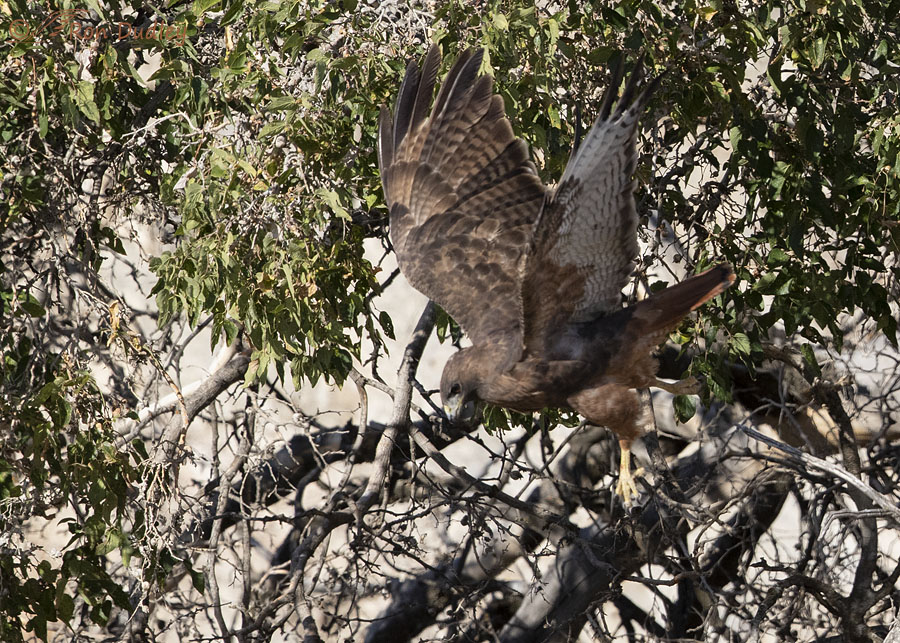
1/2500, f/6.3, ISO 800, Canon 7D Mark II, Canon EF 500mm f/4L IS II USM + EF 1.4 III Extender, not baited, set up or called in
Here his right leg and foot is trailing behind after it left the branch.
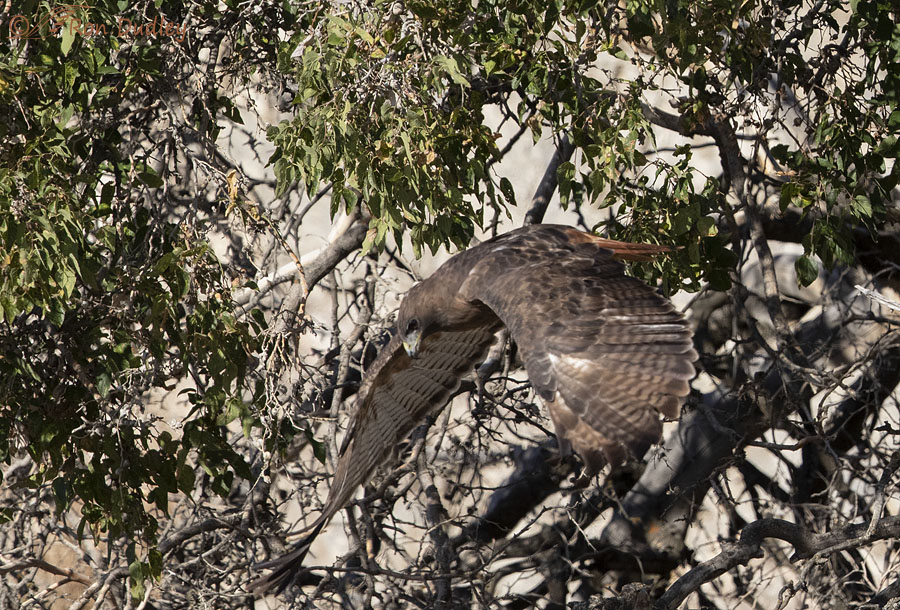
1/2500, f/6.3, ISO 800, Canon 7D Mark II, Canon EF 500mm f/4L IS II USM + EF 1.4 III Extender, not baited, set up or called in
And then he was gone, continuing in the direction that was his original intention.
So now we know what he did but the pertinent question is… why did he do it? Here’s my theory, for what it’s worth.
It’s my guess that he used his right foot to push off of the the branch as a method of accelerating and gaining extra speed quickly. I think it’s likely that all the branches and leaves around him prevented him from using his wings as efficiently as usual during takeoff so he took advantage of the conveniently-placed branch for extra spring immediately after launch.
At this point you may be wondering, why does it matter? Why am I devoting an entire post to such a seemingly inconsequential detail? All I can say is it matters to the hawk so it matters to me.
Besides, everything I can learn about the behavior of my subjects has the potential of making me a better bird photographer.
Ron


Wow! Bird skipping LOL! I like to skip too 🙂
Absolutely stunning AND I love to learn all things about birds so keep em coming, Ron!
Nice sequence and interesting observations. He seemed to be using it as a spring-loaded vault platform.
Thanks, Kenneth.
Man, it’s hard to get past this guy’s utter beauty to worry/wonder about anything else in these images! But the way he’s grabbed the tip of that little branch—and especially his look of intensity in the tight crop—tells me he had a plan, even if we can only guess what it was. And those uplifted wings—glorious! 😎
Chris, I’m convinced he had plan. I think they often do.
So interesting! Makes you wonder – if he regularly uses that bare branch as a dining table, and knows that it’s tricky to get out of there, does he do that maneuver each time he leaves too?
April describes the parent hawks at the cluttered nest opening the runways – getting rid of the snagging twigs, and the babies learning the flight paths.
Years ago, there were cameras on the RTH nest on the ledge of an NYU building in New York City. It was fascinating to watch, and in retrospect, how perfectly repetitious they were – like a gymnast who has the routine down perfectly – step, step, open wings, fly, twist, weave thru these branches and land on a favorite perch. Dedicated hawk watchers usually knew exactly where to look for each hawk at any point in the day.
“does he do that maneuver each time he leaves too?”
I’ll be watching for it next time, Carolyn. You can count on it.
Your theory makes complete sense to me, but I am not a hawk. How I would love to hear from the red-tail…
EC, next time I see him I’ll tell him you asked? 🙂
Another series where you show something we don’t often see.
I agree with your hypothesis. Another one is that he thought of using that as a perch. But as soon as he grasped it with his right talons, the branch bent and he realized it wouldn’t support him. So he instantly decided to move on. Much as we would do if we step on something unstable. I thought this as the branch seemed before he stepped on it. The problem with this hypothesis is why give up a good perch for another close by that may not hold him. So I think yours is more plausible.
Thanks, Kent. With birds it’s often difficult to be sure about motivation.
While the foot grasp is an interesting study, those are also some excellent wing shots! PS: Just curious, are you carpeting that beautiful wood flooring you showed us?
No Jamila, the carpet went into the other parts of my house.
I have watched raptors do a run and push off from branches while starting to fly from a perched position, but is usually when they are in cluttered areas with twigs and branches. They don’t seem to unfurl their wings to full extent til clear of snags. There was a redtail nest a couple of years ago in the Wasatch that was too cluttered for photos but fun to watch through my lens. The parents had to hop and flap to gain balance and clearing for take off. I watched as the parents would try to clear off some of the smaller branches in the way by biting them off. When the juveniles fledged the nest location in the old dead cluttered tree gave them fits with learning to fly. I even watched as one youngster held on upside down by one foot then dropped down into the tangled branches below. I think I still have a few photos saved somewhere.
April, those hawks must have been both fun and interesting to watch.
Fascinating! It reminds me of a spring board for sure. Very interesting series.
Good. Thanks, Bruce.
Remarkable what rapid fire photography can reveal. I buy into your theory about why he used that branch. Definitely logical. As always an excellent post. That is so hard to capture that sequence while keeping sharp and not clipping wings.
Thanks very much, Everett.
You present another subtle but thought-provoking post. I certainly cannot think of a better explanation of his behavior. Perhaps a stretch, butI think it begs the question as to whether this constitutes tool use.
At first I thought for sure this must be a different Hawk because he’s not on a lichen-covered rock or clffside.
Believe me Lyle, those lichen-covered rocks/cliffs were very close by.
I think he likes to eat here because all the branches give him cover while he’s eating and that big bare branch serves as an excellent dining table.
Interesting! Amazing what they figure out in order to handle a situation! 🙂 I would never have imagined something like that…..
Glad you found it interesting, Judy. I was afraid everyone might think I was focusing too much on what some might call ‘minutia’.
Excellent series Ron, thanks for sharing!
Charlotte Norton
Thanks, Charlotte.
Ah! Interesting! Sort of like how a swimming pool board diver uses that purposeful right foot on the board to propel herself up and out for that extra push off the board!
Yup, kinda like that.